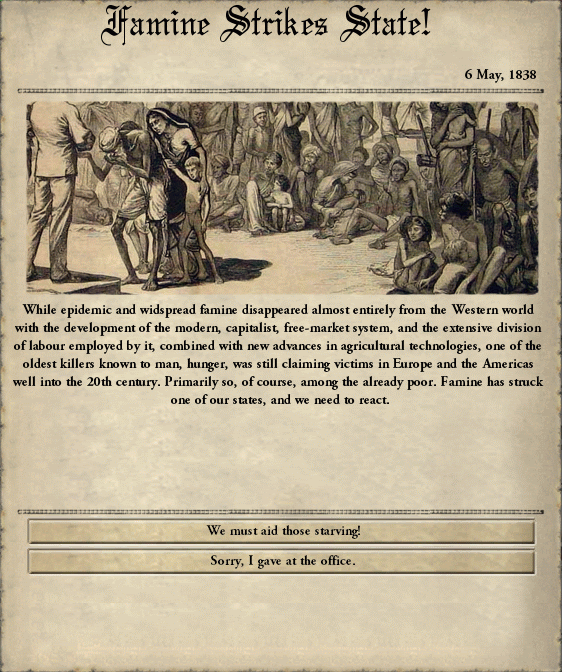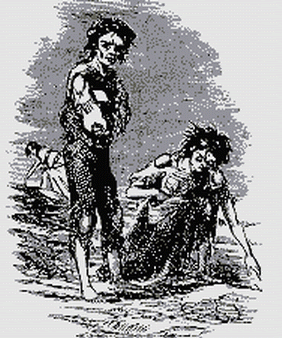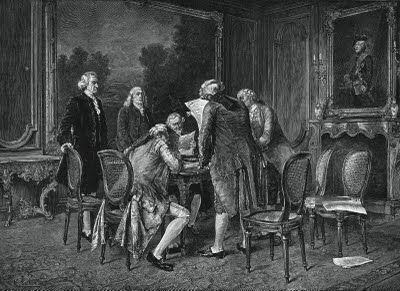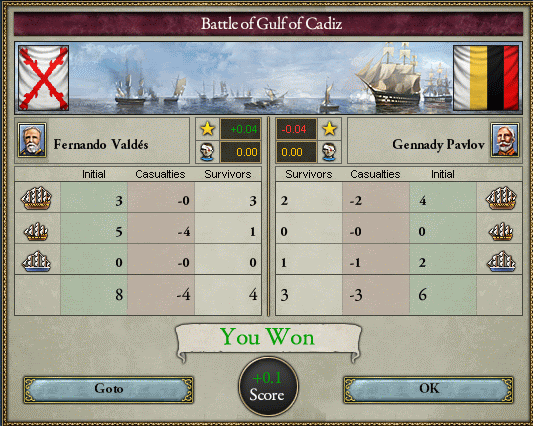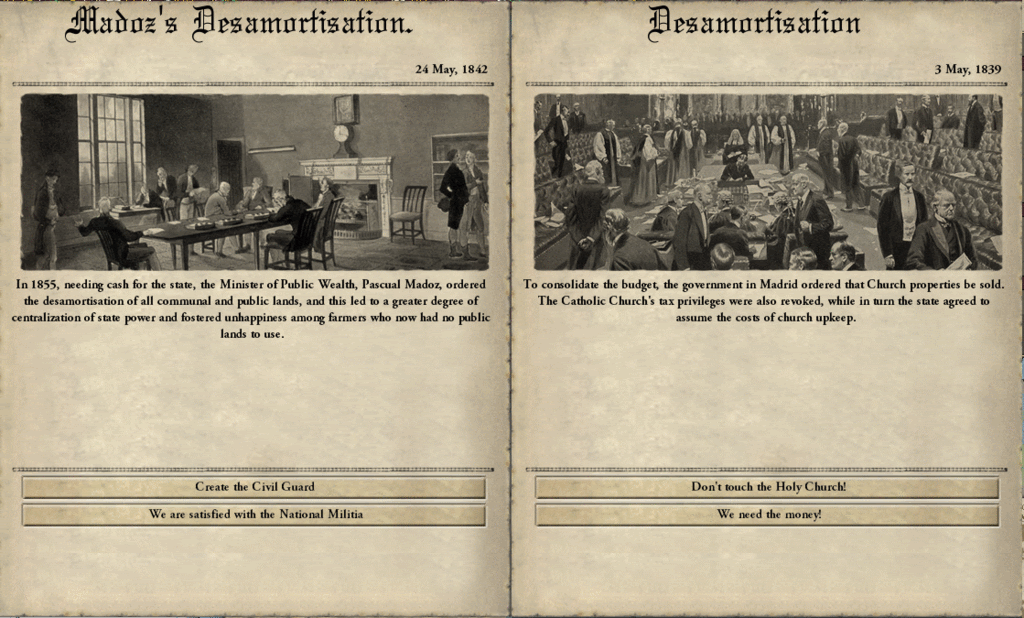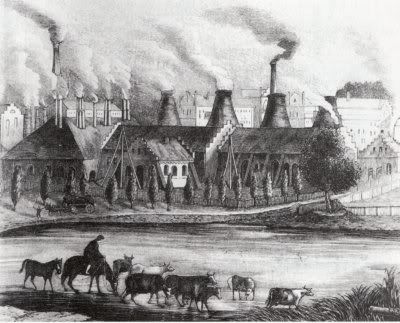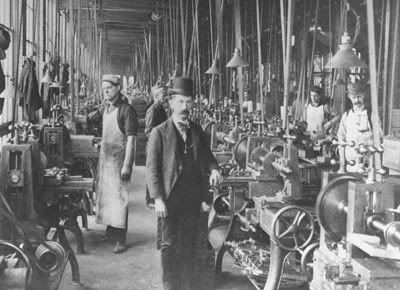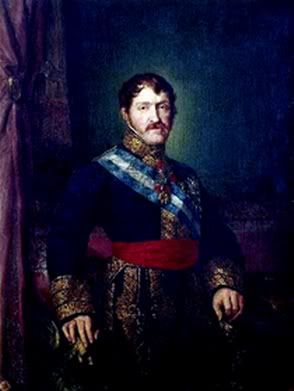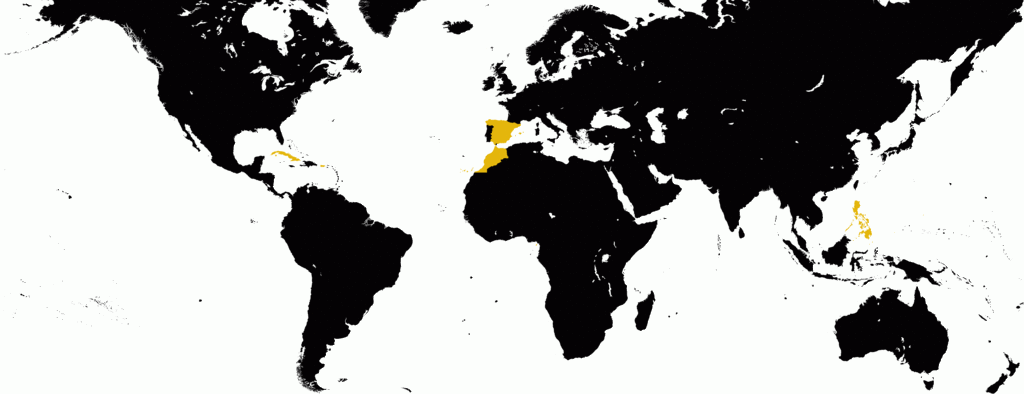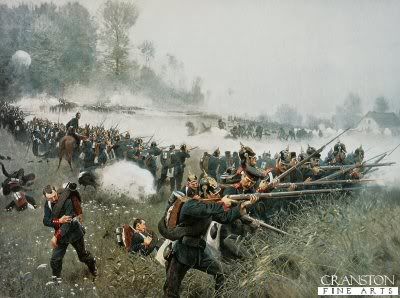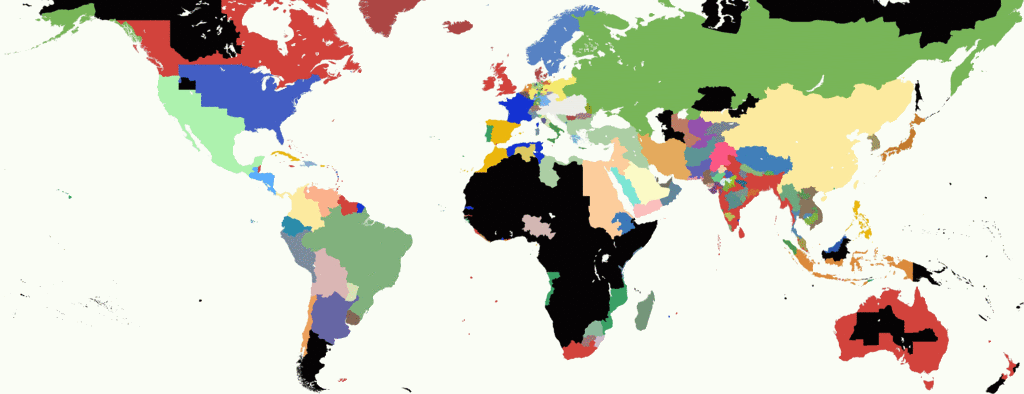Spain Upon the Succession of Carlos V – March 4th 1838
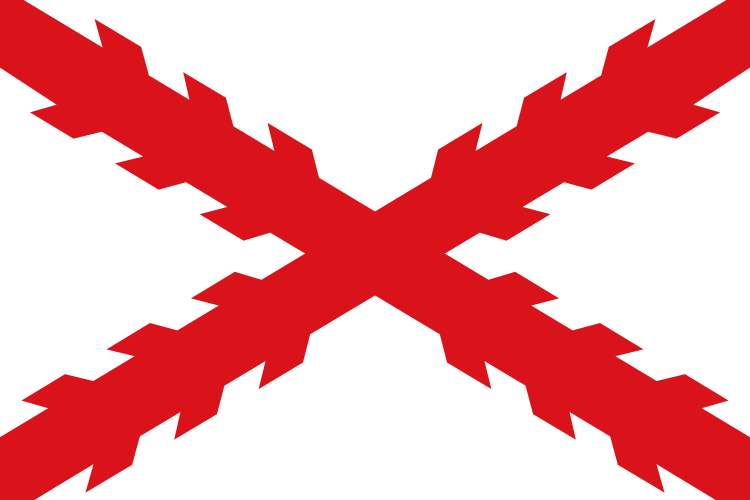
The new King wanted to radically change and rejuvenate his ailing Kingdom. Under the new banner of the Spanish nation the once mighty Empire would stretch across the world once more. Spain would again be a world superpower.
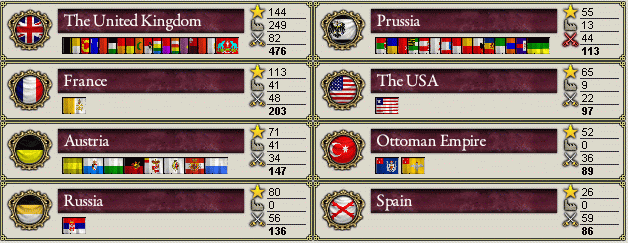
Yet the Kingdom Carlos ascended to in 1838 barely clung to its position as a Great Power. Spain was almost totally lacking in any form of industry. Whilst Britain’s industrial revolution was in full swing with France and Austria just beginning theirs Spain risked being left behind if she failed to revolutionise her economy. Meanwhile the new regime had the problem of lacking friends in Europe. France and Britain had both sent soldiers to fight the Carlists during the Revolution while the ideological allies of the Carlists (Prussia, Russia and Austria) had refused to embrace Spain as one of their own. Indeed by his coronation Carlos had already been rebuffed from his attempt to gain admittance to the Holy Alliance. The only real reason Spain was still considered a Great Power was its immense military strength. A large land army – a relic from 3 decades of near constant warfare in Spain and her colonies – and a huge but aged fleet made Spain the number 3 military power on earth behind only Britain and China.
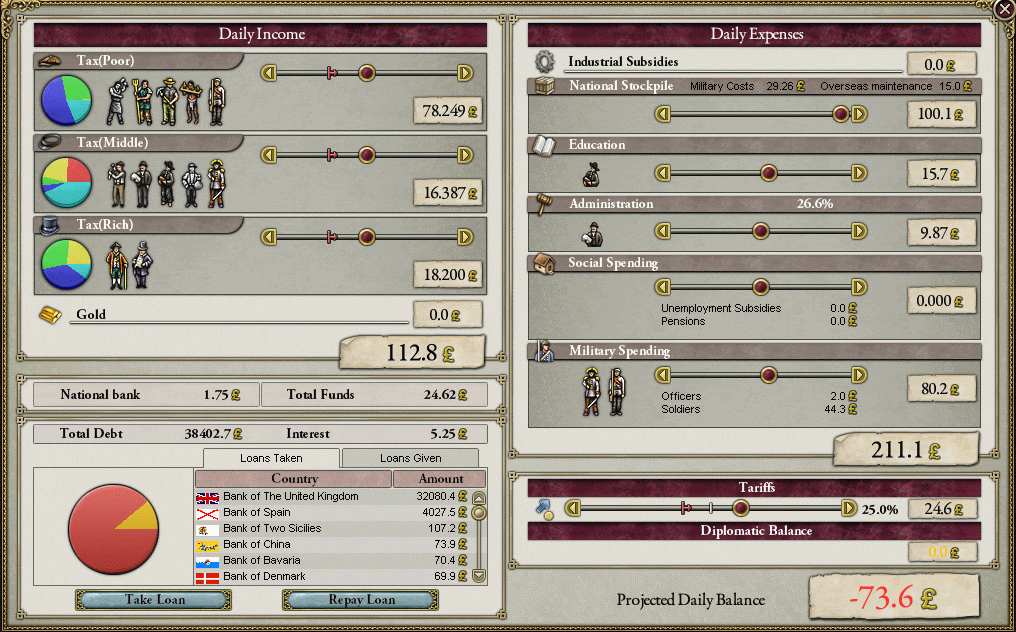
Spain’s economy was even worse than her position amongst the Great Powers. The government had over £38,000 of debt with £32,000 owed to the United Kingdom. The money owed to the British was passed on from the previous regime and the British had insisted on hiking up the interest rate on that loan following Carlos’ victory. Yet the Spanish budget remained firmly in the red and Carlos was now being forced to borrow from whoever would lend to him (Spain secured credit from a mixture of her own people, Russia and a series of German states). Attempts to save Spain’s finances convinced the Carlist government to raise high taxes and place a 25% tariff on imported goods – this in turn was devastating the artisan class who found their production no longer profitable.
The financial issues of Spain had convinced the Carlist faction that something drastic had to be done to change the Spanish economy. Therefore they planned to secure a loan of around £4,000 with which they could invest in basic industry. Spain was a country abundant in iron ore, the Spanish mainland was one of Europe’s greatest centres of production of the ore whilst the Philippines also produced it in significant quantities. Spain also had some coal production, largely focussed in Galicia yet the price of coal was low due to increased production elsewhere in the world. At the same time the industrialising states in Austria, France, Britain and Russia (Russia had already began a massive program of industrial investment) were demanding huge quantities of steel and cement. Therefore the government decided that these two products should be supplied by Spain.
It was decided to invest the money in the Castile-Leon area and the Neuva Castile area. In Castile-Leon a steel mill would be constructed in Burgos and a cement factory in Salamanca whilst to the South Madrid would receive both a steel mill and a cement factory.
It took months before the plans were finalised and the loan was not secured until October. The Austrians had decided to provide the £4,000, hoping to both export coal to Spain and to benefit from the new production. Work on the factories would not begin until January. It seemed Spain’s economic future might lie in industry.
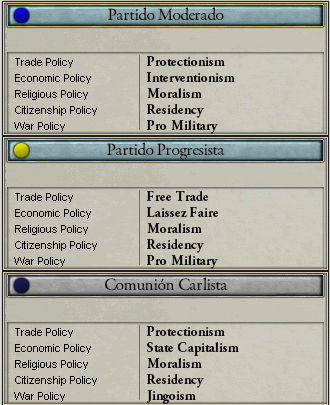
At court the Comunion Carlista was in total control. The ousted Partido Progresista remained legal but was ignored and weakened. At the same time the Partido Moderado – a powerful force during Ferdinand VII’s rule was left sidelined. The Comunion Carlista was heavily anti-capitalist and pro-church. Indeed the party was largely made up of aristocrats and clergy. The faction’s support for the industrial program in central Spain proved its intentions were not to hold back progress but to make sure progress was made in a way beneficial to Spain and not solely to Spain’s bourgeoisie.
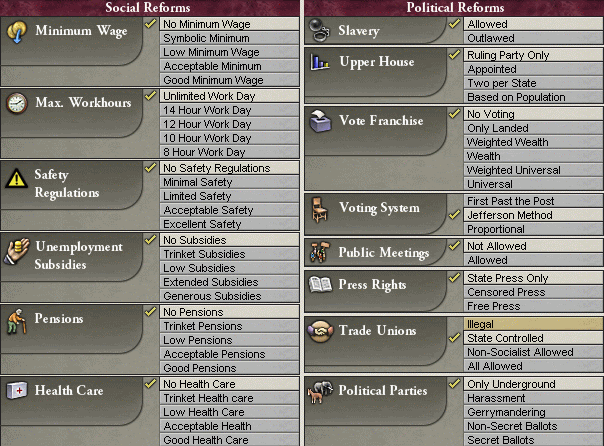
As soon as he returned to power Carlos ripped up the 1812 Constitution that had been reinstated by the liberals during the Civil War. Despite some pressure from the Church Carlos had not banned slavery (something not even the liberals would do), both the Upper and Lower Houses of Spanish government were abolished as total power was centred around the King and his court, large congregations for political purposes were banned and the press was placed under the control of the state and the church. Interestingly Carlos did not ban Trades Unions; instead he placed them under state and church control. This again seemed to be an example of the Carlist belief that they were reinstituting absolutionism not for the benefit of a small elite but for the benefit of the Spanish people. These Trades Unions would try to secure adequate pay and conditions for Spain’s working lower classes whether they be in the new factories, in the iron mines of in the fields.

Spain was now ready to go out into the world. To secure her place among the Great Powers, to create a new Empire, to save her economy and to bring pride back to a broken nation.

The new King wanted to radically change and rejuvenate his ailing Kingdom. Under the new banner of the Spanish nation the once mighty Empire would stretch across the world once more. Spain would again be a world superpower.

Yet the Kingdom Carlos ascended to in 1838 barely clung to its position as a Great Power. Spain was almost totally lacking in any form of industry. Whilst Britain’s industrial revolution was in full swing with France and Austria just beginning theirs Spain risked being left behind if she failed to revolutionise her economy. Meanwhile the new regime had the problem of lacking friends in Europe. France and Britain had both sent soldiers to fight the Carlists during the Revolution while the ideological allies of the Carlists (Prussia, Russia and Austria) had refused to embrace Spain as one of their own. Indeed by his coronation Carlos had already been rebuffed from his attempt to gain admittance to the Holy Alliance. The only real reason Spain was still considered a Great Power was its immense military strength. A large land army – a relic from 3 decades of near constant warfare in Spain and her colonies – and a huge but aged fleet made Spain the number 3 military power on earth behind only Britain and China.

Spain’s economy was even worse than her position amongst the Great Powers. The government had over £38,000 of debt with £32,000 owed to the United Kingdom. The money owed to the British was passed on from the previous regime and the British had insisted on hiking up the interest rate on that loan following Carlos’ victory. Yet the Spanish budget remained firmly in the red and Carlos was now being forced to borrow from whoever would lend to him (Spain secured credit from a mixture of her own people, Russia and a series of German states). Attempts to save Spain’s finances convinced the Carlist government to raise high taxes and place a 25% tariff on imported goods – this in turn was devastating the artisan class who found their production no longer profitable.
The financial issues of Spain had convinced the Carlist faction that something drastic had to be done to change the Spanish economy. Therefore they planned to secure a loan of around £4,000 with which they could invest in basic industry. Spain was a country abundant in iron ore, the Spanish mainland was one of Europe’s greatest centres of production of the ore whilst the Philippines also produced it in significant quantities. Spain also had some coal production, largely focussed in Galicia yet the price of coal was low due to increased production elsewhere in the world. At the same time the industrialising states in Austria, France, Britain and Russia (Russia had already began a massive program of industrial investment) were demanding huge quantities of steel and cement. Therefore the government decided that these two products should be supplied by Spain.
It was decided to invest the money in the Castile-Leon area and the Neuva Castile area. In Castile-Leon a steel mill would be constructed in Burgos and a cement factory in Salamanca whilst to the South Madrid would receive both a steel mill and a cement factory.
It took months before the plans were finalised and the loan was not secured until October. The Austrians had decided to provide the £4,000, hoping to both export coal to Spain and to benefit from the new production. Work on the factories would not begin until January. It seemed Spain’s economic future might lie in industry.

At court the Comunion Carlista was in total control. The ousted Partido Progresista remained legal but was ignored and weakened. At the same time the Partido Moderado – a powerful force during Ferdinand VII’s rule was left sidelined. The Comunion Carlista was heavily anti-capitalist and pro-church. Indeed the party was largely made up of aristocrats and clergy. The faction’s support for the industrial program in central Spain proved its intentions were not to hold back progress but to make sure progress was made in a way beneficial to Spain and not solely to Spain’s bourgeoisie.

As soon as he returned to power Carlos ripped up the 1812 Constitution that had been reinstated by the liberals during the Civil War. Despite some pressure from the Church Carlos had not banned slavery (something not even the liberals would do), both the Upper and Lower Houses of Spanish government were abolished as total power was centred around the King and his court, large congregations for political purposes were banned and the press was placed under the control of the state and the church. Interestingly Carlos did not ban Trades Unions; instead he placed them under state and church control. This again seemed to be an example of the Carlist belief that they were reinstituting absolutionism not for the benefit of a small elite but for the benefit of the Spanish people. These Trades Unions would try to secure adequate pay and conditions for Spain’s working lower classes whether they be in the new factories, in the iron mines of in the fields.

Spain was now ready to go out into the world. To secure her place among the Great Powers, to create a new Empire, to save her economy and to bring pride back to a broken nation.
Last edited:


